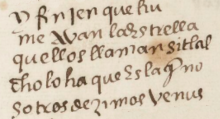Citlalcholoaqui (TR44v)
This colorful painting of the compound glyph for Venus (Citlalcholoaqui) shows a canal-like container, outlined in yellow and containing the blue sky (ilhuicatl). In the middle of the sky is one large, white star (citlalin). The star must be the morning star, Venus. Above the sky, four scrolling puffs of smoke escape, perhaps indicating the verb choloa (to run or jump), which has a role in the Nahuatl name for Venus. The smoke curls are dark gray on the outside, orange on the inside, and red at the base.
Stephanie Wood
Venus is the second planet from the sun, but it is often called either the Morning Star or the Evening Star, which are times of day when it can be especially visible. This association with the rising and setting sun did not go unnoticed. The planet therefore had different names based on the timing of its visibility: "Entre los nahuas Venus es Tlahuizcalpantecuhtli por la mañana y Xólotl por la tarde" says María Teresa Uriarte, Arte y arqueología en el altiplano central de México (2018). Miguel León-Portilla points out that Venus--which he says was called Citlalpol or Hueicitlalin--was linked to Quetzalcoatl dating back to the time of Teotihuacan. See his book, Aztec Thought and Culture (2012), 51.
Stephanie Wood
y finjen que hu[-]
meavan la estrella
quellos llaman sitlal[-]
cholohaque Es la q~ no[-]
sotros dezimos venus
and they allege that the star that they call Citlalcholoaqui, which is the one that we call Venus, used to smoke
Stephanie Wood
ca. 1550–1563
Jeff Haskett-Wood
stars, estrellas, cometas, humear, huir, sciencias, science, astronomy

choloa, to run away or jump, https://nahuatl.wired-humanities.org/content/choloa
choloani, one who runs away, https://nahuatl.wired-humanities.org/content/choloani
Venus
Stephanie Wood
Telleriano-Remensis Codex, folio 44 recto, MS Mexicain 385, Gallica digital collection, https://gallica.bnf.fr/ark:/12148/btv1b8458267s/f114.item.zoom
The non-commercial reuse of images from the Bibliothèque nationale de France is free as long as the user is in compliance with the legislation in force and provides the citation: “Source gallica.bnf.fr / Bibliothèque nationale de France” or “Source gallica.bnf.fr / BnF.”





